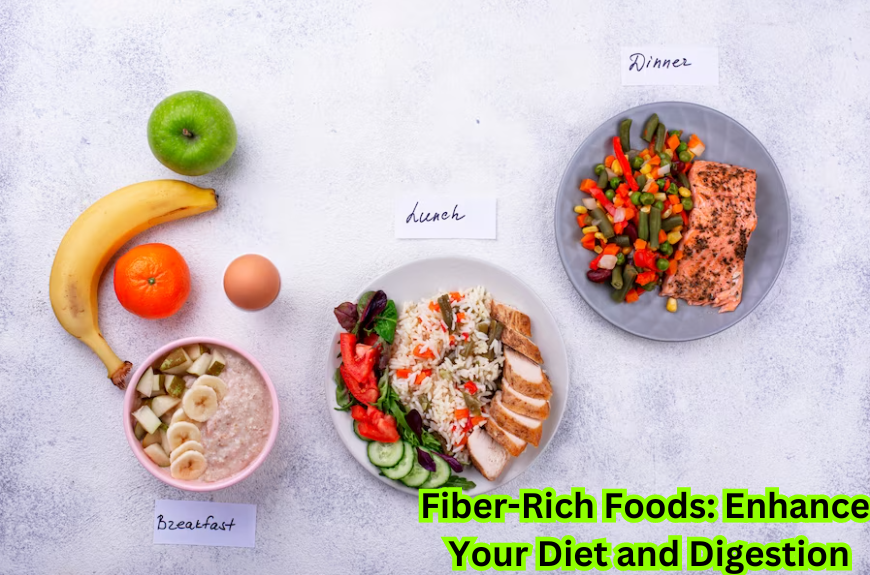A well-balanced food is very important for people who want to live a healthy life. Dietary fiber is an important part that is often ignored. This piece will discuss fiber-rich foods and how they can help your digestive and general health. Come with me as I show you all the great things that can happen when you eat fiber-rich foods daily.
Learning About Fiber
Before we get into the many foods high in fiber, let us go over the basics. Fruits and vegetables contain fiber, a carbohydrate that the body can not fully break down. Not soluble and soluble are the two main types.
Soft fiber is good for your heart.
When water mixes with soluble fiber, it turns into a gel-like material. This kind of fiber is known to be good for your heart. Foods high in soluble fiber include oats, beans, and veggies. It lowers cholesterol and checks blood sugar, making it a great choice for people with diabetes.
The digestive powerhouse that is insoluble fiber
Insoluble fiber, conversely, makes stools bulkier and helps keep you from congesting. Some foods high in insoluble fiber are whole grains, veggies, and nuts. This fiber helps keep the digestive system healthy by promoting normal bowel movements and avoiding stomach problems.

What Fiber-Rich Foods Can Do for You
Now that we have covered the basics let us look at the wide range of fiber-rich foods that are easy to add to your diet.
Whole Grains for Health That is Whole
Choose a range of whole grains to start your fiber journey. Choose oats, brown rice, whole wheat, and quinoa. Not only are these foods high in fiber, they are also full of important nutrients like minerals, vitamins, and antioxidants.
Types of legumes are beans, lentils, and chickpeas.
Beans, lentils, and chickpeas are cheap protein sources and very high in fiber. Add them to soups, salads, or main meals for more fiber daily. As a result of their flexibility, they are a great addition to any diet.
Fruits and vegetables with lots of color
There are a lot of fiber-rich foods and veggies in nature. You can choose from berries, apples, pears, broccoli, carrots, and spinach. Their bright colors show they are full of different nutrients and vitamins, making them very important for your health.
Nuts and seeds are full of nutrients in a small package.
Sunflower, chia, flaxseeds, and almonds are all healthy snacks high in fiber and good fats. For a crunchy fiber boost, sprinkle them on yogurt, blend them into soups, or eat them as a snack.
The Digestive Dance: How Fiber Helps Keep Your Gut Healthy
Gut health is very important for general health, and fiber is the main thing that helps keep the gut healthy.
Keeping bowel movements in check
To keep you from getting constipated and to keep your bowel movements normal, eat a lot of whole grains and veggies. They contain insoluble fiber that gives stool bulk. This easy but important job is necessary for the digestive system to work well.
Keeping the balance of gut microbiota
Your gut’s good bugs, called probiotics, use fiber as food. Fiber-rich foods help keep the microbiota in your gut different and healthy, which helps your digestion and makes your immune system stronger.
Keeping Digestive Disorders at Bay
People who eat a lot of fiber may be less likely to get gut problems like diverticulitis, irritable bowel syndrome (IBS), and colon cancer. It is impossible to say enough good things about fiber’s role in keeping gut health.
Fiber and Keeping Your Weight Down
In addition to helping your digestive system, fiber is very important for keeping your weight in check.
Satisfied and Full:
Fiber-rich foods take longer to chew and digest, which makes you feel full and satisfied. This can help you control your hunger and, as a result, keep your weight in check.
Loss of Calories
Many foods high in fiber, like fruits and veggies, are low in calories but high in bulk. This diluting of calories lets you eat bigger amounts without taking in many more calories, making it easier to keep a healthy weight.
How to Increase Your Fiber Intake in Real Life
Now that we have discussed how important fiber is, let us talk about some easy ways to add fiber-rich foods to your daily diet.

Incorporation Over Time
If it is not already there, incorporate fiber slowly into your diet to give your digestive system time to get used to it. Adding a lot of fiber all at once can cause brief gas and bloating.
Conclusion
In conclusion, fiber-rich foods benefit you more than just your gut health. Fiber is a superfood that should take up a lot of space on your plate because it helps keep your heart healthy and your weight in check. Eat a wide range of colored fruits, veggies, whole grains, legumes, nuts, and seeds to get enough fiber and improve your health. Therefore, let us consciously add fiber to our meals and enjoy the benefits of living a better, more energetic life.
FAQ:
Welcome to our full guide on Fiber-Rich Foods: Improve Your Diet and Digestion. This article takes you on a trip through the world of dietary fiber, looking at its many benefits and tips on how to easily include fiber-rich foods in your daily life. As we go through frequently asked questions (FAQs), we hope to take the mystery out of fiber so that it is not just a food choice but a way of life.
What kinds of foods are high in fiber?
A wide range of plant-based foods are high in dietary fiber, an important part of a healthy diet. Whole grains like brown rice and quinoa, legumes like beans and lentils, a wide range of colored fruits and veggies, and nuts and seeds are all examples of these foods. These fiber-rich foods are important for gut health and contain many important nutrients, making them an important part of a healthy, well-balanced diet.
What Does Fiber Mean in Food?
Foods high in dietary fiber, or just “fiber,” have a carbohydrate that our bodies can not fully process. Not soluble and soluble are the two main types. When water mixes with soluble fiber, it forms a gel-like material. Insoluble fiber, conversely, makes stools bulkier, which helps digestion. Both types are good for your health, like keeping your blood sugar levels in check, protecting your heart, and keeping your gut system healthy.
What kinds of foods are high in fiber?
Despite what many people think, foods high in fiber can be easy to digest and good for your gut health. Although some high-fiber foods may initially make people bloated or gassy, the body gets used to them over time. In addition to helping digestion, fiber encourages frequent bowel movements, avoids constipation, and supports healthy gut flora.
How does fiber help your digestive health and make you feel fuller?
Fiber is a great substance that can make you feel full for longer. Fiber-rich foods make you feel fuller. After all, they take longer to chew and digest. In addition, fiber soaks up water, which makes the food in your stomach bigger. Not only does this help control your hunger, but it also lets you keep your weight in check.
Fiber is very important for gut health because it helps keep bowel movements predictable. One type of fiber that helps keep your digestive system healthy is insoluble fiber, which makes stools bulkier. In addition, fiber is a prebiotic that feeds the good bacteria in your gut and helps keep the microbiota balanced and healthy. This positive connection between fiber and gut health shows how important it is to eat fiber-rich foods daily. See more.

